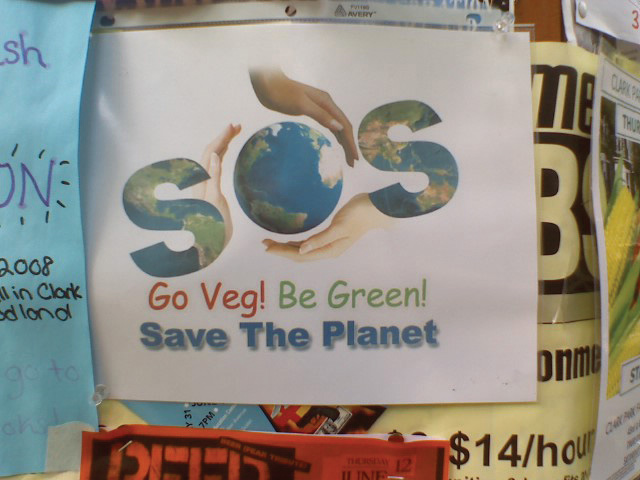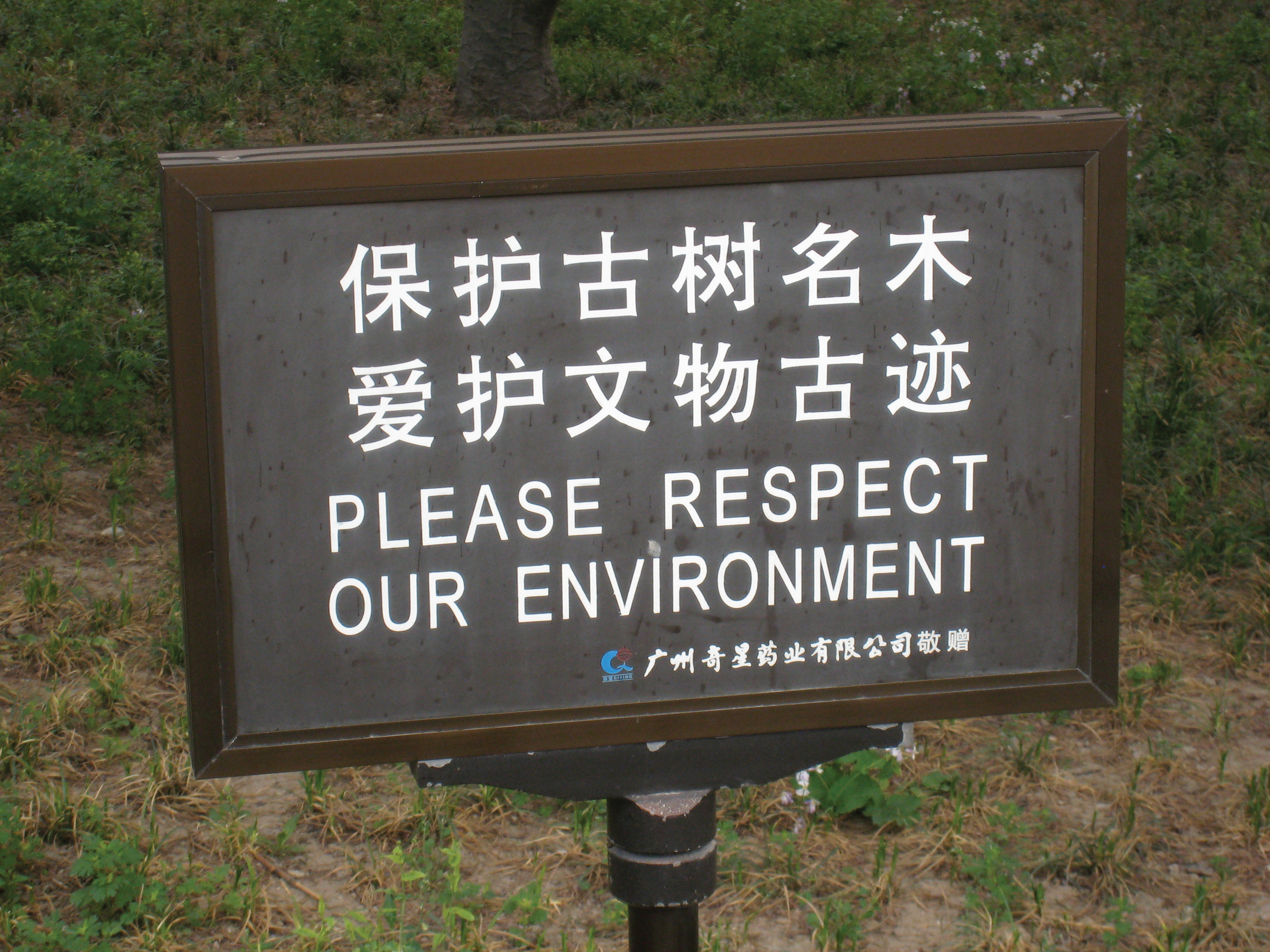
Source: Photo courtesy of Kim Woodbridge, http://www.flickr.com/photos/kwbridge/2541993688.
Some people argue that there’s no ethical requirement to protect the environment because the natural world has no intrinsic value. Against that ethical posture, here are four broad justifications for environmental protection. Each begins with a distinct and fundamental evaluation:
On a Yahoo! forum page, a student named redbeard_90 posts the question “why should we save the planet?” and partially explains this way: “With all the constant talk of ‘saving the planet’ and stopping global warming, should we actually try to stop it? Perhaps in a way, this is humans transforming the planet to better suit us?”“Why Should We Save the Planet?,” Yahoo! Answers, accessed June 8, 2011, http://answers.yahoo.com/question/index?qid=20080610193018AA7IQt2.
It sounds like redbeard_90 might think that humans doing damage to the environment is OK because it’s just a symptom of “humans transforming the planet to better suit us.”
The response by a woman named Super Nova includes this reasoning: “We should try to save the planet because there would be less people with health problems. Did you know that there are more people with respiratory problems because of all the air pollution contributing to it? Also, we should think about future generations on Earth and how it would affect our future. Also, global warming is affecting our essential natural resources like food and lakes are drying up and it is causing more droughts in the world.”
The overall tone of her answer is strong with conviction.
The poster named Luke writes an animated response, including these sentences:
The first thing we need to do is help make some changes in our national mind set from one that lets us believe that our earth can recover from anything, to one that lets us believe that our earth could use a little help.
Developing cleaner ways to produce electricity is not going to hurt a thing; if it does nothing but make the air we breathe cleaner it works for me.
Developing alternative fuels to power our transportation needs, again won’t hurt a thing, reduce the demand for oil you reduce the price we pay for it, I think everyone can say “that works for me” to this.
I’m a global warming advocate but, not because of some unfounded fear of Doomsday but (as you may have guessed by now) because it won’t hurt a thing to help our earth recover from years of industrial plunder.
The poster named scottsdalehigh64 is the most intense. He’s also fairly experienced: assuming his username is true and he graduated high school in 1964, he’s about retirement age now. He writes, “There is an alternate question: Why do we think we have a right to be so destructive to other life forms on the planet? Perhaps the best answer is that we want to leave a good place to live for the species that are left when we go extinct.”
Unlike most of the other posters, he doesn’t include any personal note or “best wishes” type line in his response. He’s focused and intense.
Scottsdalehigh64 doesn’t seem to like those who are “destructive to other life forms on the planet.”
An excited poster, KiRa01, announces, “Just live like theres no tomorrow!!!!”
With respect to the environment, justify his attitude in ethical terms.

Source: Photo courtesy of Elliott Brown, http://www.flickr.com/photos/ell-r-brown/4601959323.
Fifty years ago airports were designed to reward fliers with architecture as striking as the new experience of flight was rare and exciting. From those early days, only a few airports remain unspoiled by renovation and expansion. The Long Beach Airport south of Los Angeles is a survivor. The low lines of midcentury modern architecture captivate today’s visitors just as they did the first ones. The restaurant overlooking the tarmac remains as elegant and perfectly simple as always. Walking the concourse, it’s easy to imagine men in ties and women and children in their Sunday clothes waiting for a plane while uniformed porters manage their suitcases.
Flying is different today—no longer exciting and rare, it’s just frustrating and crowded. Recognizing that reality, when the large European nations combined to form an airplane manufacturer, they didn’t choose a distinguished and elevated name for their enterprise, they just called it Airbus: a company that makes buses that happen to go up and down.
Airplanes are tremendously polluting. In the United States, large passenger flights account for about 3 percent of released greenhouse gasses. That doesn’t sound like much, but when you compare the number of flights with car trips, it’s clear that each airplane is billowing massive carbon dioxide. And the problem is only getting worse, at least on the tourism front. Over the course of the next decade, global tourism will double to about 1.6 billion people annually.
Tourists aren’t the only fliers. Planes are also taken by people heading to other cities to talk about tourism. One of them, Achim Steiner, is the executive director of the United Nations Environment Program. At a recent conference in Spain, he said, “Tourism is an extraordinary growth industry, it’s the responsibility of operators—from hoteliers to travel companies—as well as governments to ensure that sites are sustainable.”James Kanter, “How Do You Measure Green Tourism?,” New York Times, October 6, 2008, accessed June 8, 2011, http://green.blogs.nytimes.com/2008/10/06/is-there-any-such-thing-as-green-tourism.
Sustainability has at least two sides. On one side, there’s the economic reality: revenue provided by visitors pays for needed services. An example comes from the Masai Mara park reserve in Kenya. In villages surrounding the park, schools were forced to close when political unrest scared away the tourists and their money. On the other side, sustainability also means environmental protection. According to Steiner, there’s the possibility that “Masai Mara could be overused to the point where it loses its value.”
According to Steiner, “Hoteliers, travel companies, and governments are responsible” for ensuring the sustainability of sites including Masai Mara. In most discussions about paying the costs of a clean environment, three groups are signaled:
How do each of these three fit into Steiner’s vision?
Airplane exhaust contributes significantly to the damage currently being done to the environment. Steiner rode an airplane to a city to talk about that damage.
Fifty years ago, airplanes contributed almost no pollution to the environment because so few could afford to fly. One way to limit the amount of pollution into the air is through incentives. In the airplane case, a large tax could be attached to an airline ticket, thus providing an incentive to tourists to stay home or use alternate sources of transportation. Of course, for the very wealthy, the tax will be more absorbable and, presumably, airplane travel would tend toward its origins: flying would be something the rich do.
How could a utilitarian analysis be used to justify the action of, in essence, reserving plane flying for the rich in the name of helping the environment?
The airport at Long Beach is a low-ranking historical treasure. Tourists will never flock to see it, but it does incarnate and vivify a time in the recent past. The airport at Long Beach is also a business. That may lead its directors to initiate remodeling and expansion plans that will destroy the airport’s original essence.

Source: Photo courtesy of p_a_h, http://www.flickr.com/photos/pahudson/2212158878.
Bernadette Patrick moved away from her home in Endicott, New York, saying this about the town: “It was very neighborly and well kept, with lots of kids and families. Then all of a sudden it seemed like they put a skull and crossbones on all the doors. It was like a scene from a science fiction movie.”Janet Gramza, “Life in the Plume: IBM’s Pollution Haunts a Village,” Post-Standard, January 11, 2009, accessed June 8, 2011, http://www.syracuse.com/specialreports/index.ssf/2009/01/life_in_the_plume_ibms_polluti.html.
The science fiction part is the large, white metal boxes attached to Endicott homes. With tubes burrowing down in the earth and shooting up high into the air, they’re wired to pump air from below and jet it above. The idea is to disperse toxic vapors rising up through the ground. The vapor’s source is industrial solvents poured down drains and dripped out of leaky pipes at the local IBM factory over the course of its seventy-five-year history.
Those seventy-five years have otherwise been good ones. IBM money and jobs drove the small town forward. As Wanda Hudak put it, “The IBM plant paid for a lot of college educations and cottages at Perch Pond.”Janet Gramza, “Life in the Plume: IBM’s Pollution Haunts a Village,” Post-Standard, January 11, 2009, accessed June 8, 2011, http://www.syracuse.com/specialreports/index.ssf/2009/01/life_in_the_plume_ibms_polluti.html. The good feelings ended when a company IBM hired started showing up at people’s homes to test the air and offer to install the mechanical ventilation systems.
IBM is paying millions for cleanup efforts. They’re installing air cleaners on homes and pumping contaminated groundwater to the surface for safe disposal. An IBM spokesman said this about the toxic pollution, “None of it was done intentionally, but we still are sticking around to take care of it. We feel obligated legally, ethically. We are not going anywhere.”Janet Gramza, “Life in the Plume: IBM’s Pollution Haunts a Village,” Post-Standard, January 11, 2009, accessed June 8, 2011, http://www.syracuse.com/specialreports/index.ssf/2009/01/life_in_the_plume_ibms_polluti.html.
One critical element of the notion of corporate social responsibility is the idea of sustainability.
One critical element of the notion of corporate social responsibility is the idea of stakeholder theory.
The IBM of Endicott, New York, is an IBM of the past, one focused on factories and making business machines like typewriters and photocopiers. The IBM of today leaves most hard manufacturing to foreign firms in low-cost countries. What IBM now wants to do now, according to their advertising, is “build a smarter planet.” That means solving problems like this one reported by CNN:
Stockholm bogs down in rush-hour traffic. A series of bridges connecting Sweden’s capital creates bottlenecks that cause gridlock and air pollution, waste millions of gallons of fuel, hamper public transportation, and endanger pedestrians.Jeffrey M. O’Brien, “IBM’s Grand Plan to Save the Planet,” CNN Money, April 21, 2009, accessed June 8, 2011, http://money.cnn.com/2009/04/20/technology/obrien_ibm.fortune/index.htm.
The solution? Swede governmental officers decided on a congestion fee, on charging vehicles money for entering the city at peak traffic times. The aim was to seriously reduce the number of cars downtown at rush hours. That’s easier said than done, however. Stopping people at toll booths would just make the problem worse: it would add yet another air-polluting stop to the traffic through town. So IBM was hired to produce camera technology allowing license plate numbers to be recorded and recognized automatically. Then monthly bills were generated and mailed out to the car owners. As CNN reported, these were the results:
Traffic fell 35 percent almost immediately and stayed down 22 percent—and not just at peak times or solely downtown. Emissions also dropped by 14 percent. The streets became more pedestrian friendly, and the buses began finishing their routes so quickly that the city had to rewrite the schedules. The fee schedule makes it obvious when traffic will be the worst, so drivers who trek in during peak hours know they’ll pay more for what will probably be a maddening experience. As a result, people seem to be cutting out unnecessary trips: bundling afterschool pickups, say, with visits to the grocery store. In short, Swedes are driving smarter.Jeffrey M. O’Brien, “IBM’s Grand Plan to Save the Planet,” CNN Money, April 21, 2009, accessed June 8, 2011, http://money.cnn.com/2009/04/20/technology/obrien_ibm.fortune/index.htm
When IBM protects the environment by cleaning up Endicott, they’re losing money; when IBM protects the environment by selling smart systems to the Swedes, they’re profiting.
In the world of business ethics and the environment, one of the more spirited debates is this: should we slow down technology and industrialization to use less and pollute less, or speed up industrialization and technology in the hope that we’ll discover solutions to the environmental problems caused by industrialization and technology?
With respect to the environment and money, there are two formulas for thinking about IBM’s project in Sweden:
In terms of basic values and ethics, outline the difference between these two visions.

Source: Photo courtesy of Tom Caswell, http://www.flickr.com/photos/caswell_tom/2426923924.
The wind farms of Northern California produce clean electricity. Every lightbulb illuminated by the giant turbines represents less destruction of the earth by mining and drilling operations, and less contamination of the air by coal- and oil-fired power plants. It also represents fewer California Condors.
The spinning blades of the windmills erected in spots including the Altamont Pass are proving deadly for the rare birds, which are a kind of vulture. Here’s a reaction by the environmental writer and activist Jim Wiegand: “For all the ‘green energy’ believers out there, this is a video you have to see. Each year across America thousands of eagles, hawks, owls, falcons, vultures and condors perish at green energy wind farms. This video will open your eyes and your mind when you see how easily a soaring vulture is smashed by the innocent looking blades of a prop wind turbine.”C. Taibibi, “California Condors, Wind Farms on Collision Course,” Examiner.com, August 30, 2009, accessed June 8, 2011, http://www.examiner.com/wildlife-conservation-in-national/california-condors-wind-farms-on-collision-course.
Fatal Accident with Vulture on a Windmill
The video shows a large and calm vulture cycling slowly around a modern wind turbine and then getting struck by one of the spinning blades. The bird drops out of the air. Left on the ground beside the towering contraption, it drags and struggles to flap its broken wing.
Unlike single-cell creatures, vultures seem to have awareness and interest in their environment. They notice distressed animals, circle patiently, and in the end descend to eat the carcass.
If you have a chance to see the video and watch the fallen bird struggling and dying on the ground, do the images change your feelings about the importance of protecting this creature?
Assume that, for whatever reason, you’re convinced that those condors being cut down by California wind turbines have ethical rights comparable with the ones we deposit in human animals. Can you nonetheless outline an argument in favor of continued windmill use because of the clean energy it provides?

Source: Photo courtesy of HaPe_Gera, http://www.flickr.com/photos/hape_gera/2929195528/.
People for the Ethical Treatment of Animals is possibly the most active animal-rights organization in the United States. On the day this case study was written, the organization’s home page featured pictures of a sad-eyed Dalmatian, a noble elephant, and a cuddly rabbit. There was also a tease to a story set underneath a picture of smiling, former President Clinton. It read, “What’s the secret behind this former president’s newly trim waistline, enhanced energy, and improved cardiovascular health? A vegan diet! Read more.”Peta.org, “Try Bill Clinton's New Diet!,” accessed June 8, 2011, https://secure.peta.org/site/Advocacy?cmd=display&page=UserAction&id=3315.
Were you in charge at PETA, an organization fighting for animal rights that depends on donations, would you use the phenomenon of anthropomorphism to boost your organization’s revenue?